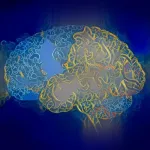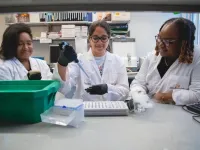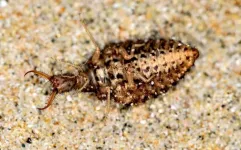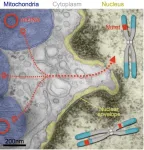(Press-News.org) Concerns over the biosecurity risks posed by artificial intelligence (AI) models in biology continue to grow. Amid this concern, Doni Bloomfield and colleagues argue, in a Policy Forum, for improved governance and pre-release safety evaluations of new models in order to mitigate potential threats. “We propose that national governments, including the United States, pass legislation and set mandatory rules that will prevent advanced biological models from substantially contributing to large-scale dangers, such as the creation of novel or enhanced pathogens capable of causing major epidemics or even pandemics,” write the authors. Advances in biological AI models hold great promise across many applications, from speeding up drug and vaccine design to improving crop yields and resilience. However, alongside these benefits, biological AI models also pose serious risks. Because of their general-purpose nature, the same model that designs a harmless viral vector for gene therapy could be used to create a more dangerous, novel viral pathogen that evades vaccines. Although developers of these systems have made voluntary commitments to evaluate the dual-use risks of these models, Bloomfield et al. highlight how these measures are insufficient to ensure safety on their own. According to the authors, there is a notable lack of governance to address risks, including standardized, mandatory safety evaluations for advanced biological AI models. Although some policy measures exist, such as the White House Executive Order on AI, and the Bletchley Declaration signed at the UK AI Safety Summit in 2023, there is no unified approach to evaluating the safety of these powerful tools before they are released. Here, Bloomfield et al. call for policies focused on reducing the biosecurity risks of advanced biological models, while preserving scientific freedom to explore their potential benefits. Policies should require pre-release evaluations only for advanced AI models posing high risks. These evaluations can use existing frameworks for dual-use research and should include proxy tests to avoid directly synthesizing dangerous pathogens. Additionally, oversight should address the risks of releasing a model's weights, which could enable third-party modifications to a model after its release. Moreover, policies must ensure responsible data sharing and restrict access to AI systems with unresolved risks.
END
Governance needed to ensure biosecurity of biological AI models
2024-08-22
ELSE PRESS RELEASES FROM THIS DATE:
Spontaneous transfer of mitochondrial DNA into the nuclear genomes in the human brain over the individual’s lifespan
2024-08-22
Somatic nuclear mitochondrial DNA (Numt) insertions are mito-nuclear gene transfer events that can arise in the germline and in cancer. This study shows that Numt insertions arise spontaneously and accumulate in brain tissues during development or over the human lifespan.
#####
In your coverage, please use this URL to provide access to the freely available paper in PLOS Biology: http://journals.plos.org/plosbiology/article?id=10.1371/journal.pbio.3002723
Article Title: Somatic nuclear mitochondrial DNA insertions are prevalent in the human brain and accumulate over time in fibroblasts
Author Countries: United States
Funding: see manuscript END ...
Cancer drug could treat early-stage Alzheimer’s disease, study shows
2024-08-22
UNIVERSITY PARK, Pa. — A type of drug developed for treating cancer holds promise as a new treatment for neurodegenerative diseases such as Alzheimer’s, according to a recent study by researchers at Penn State, Stanford University and an international team of collaborators.
The researchers discovered that by blocking a specific enzyme called indoleamine-2,3-dioxygenase 1, or IDO1 for short, they could rescue memory and brain function in models that mimic Alzheimer’s disease. The findings, published today (Aug. 22) in the journal Science, suggest that IDO1 inhibitors currently ...
Drugs that improve brain metabolism could help Alzheimer’s patients
2024-08-22
Among the many ways neuroscientists think Alzheimer’s disease may strip away brain function is by disrupting the glucose metabolism needed to fuel the healthy brain. In essence, declining metabolism robs the brain of energy, impairing thinking and memory.
Against that backdrop, a team of neuroscientists at the Knight Initiative for Brain Resilience at Stanford’s Wu Tsai Neurosciences Institute have zeroed in on a critical regulator of brain metabolism known as the kynurenine pathway. They hypothesize that that the kynurenine pathway is overactivated as a result of ...
Life after (feigned) death
2024-08-22
A new study led by scientists from the University of Bristol has revealed what animals do after they have feigned death in order to avoid being killed by a predator and what the context of this behaviour is.
Many animals, as a last-ditch defence, become motionless after being contacted by a predator.
This behaviour is so common that it's recognised in such phrases as “playing possum”. It is even said to occur in humans in extreme circumstances.
In previous studies, carried out by the same team using antlion larvae, scientists noticed that they become motionless after being individually handled.
At one point ...
Fisheries research overestimates fish stocks
2024-08-22
Many fish stocks around the world are either threatened by overfishing or have already collapsed. One of the main reasons for this devastating trend is that policymakers have often ignored the catch limits calculated by scientists, which were intended to be strict thresholds to protect stocks. But it has now become clear that even these scientific recommendations were often too high.
In the European Union (EU), for example, fisheries are primarily managed through allowable catch limits, known as quotas, which are set by the European ...
AI tackles one of the most difficult challenges in quantum chemistry
2024-08-22
New research using neural networks, a form of brain-inspired AI, proposes a solution to the tough challenge of modelling the states of molecules.
The research shows how the technique can help solve fundamental equations in complex molecular systems.
This could lead to practical uses in the future, helping researchers to prototype new materials and chemical syntheses using computer simulation before trying to make them in the lab.
Led by Imperial College London and Google DeepMind scientists, the study is published today in Science.
Excited molecules
The team investigated the problem of understanding ...
Mitochondria are flinging their DNA into our brain cells
2024-08-22
NEW YORK, NY (Aug. 22, 2024)--As direct descendants of ancient bacteria, mitochondria have always been a little alien.
Now a study shows that mitochondria are possibly even stranger than we thought.
Mitochondria in our brain cells frequently fling their DNA into the nucleus, the study found, where the DNA becomes integrated into the cells’ chromosomes. And these insertions may be causing harm: Among the study’s nearly 1,200 participants, those with more mitochondrial DNA insertions in their brain cells ...
Revealing DNA behavior in record time
2024-08-22
“DNA, RNA and proteins are the key players to regulate all processes in the cells of our body,” Leiden Professor John van Noort explains. “To understand the (mis-)functioning of these molecules, it is essential to uncover how their 3D structure depends on their sequence and for this it is necessary to measure them one molecule at a time. However, single-molecule measurements are laborious and slow, and the number of possible sequence variations is massive.”
From decades to days
Now the team of scientists developed an innovative tool, called SPARXS (Single-molecule Parallel Analysis for Rapid eXploration ...
Columbia receives $400 million gift for biomedical research
2024-08-22
NEW YORK, NY (Aug. 22, 2024)--Columbia University announced today a new $400 million gift from Roy and Diana Vagelos, which will secure Columbia’s leadership in biomedical science research and education and produce a vast array of compelling opportunities for improving society’s health and wellbeing. The gift is the single largest ever made to Columbia’s medical school and, taken together with their previous giving, establishes Roy and Diana as the most generous donors in the history of Columbia University.
A ...
Air pollution harms mental health worse in New York’s historically redlined neighborhoods
2024-08-22
BUFFALO, N.Y. — Air pollution is bad for mental health. That much is clear. Now, new research shows the impact may be even worse in neighborhoods that were historically redlined.
University at Buffalo researchers looked at 17 cities across New York State where longstanding federal housing policies once denied neighborhoods with people of color from receiving mortgages. Although this practice was outlawed in 1968, the researchers found that elevated levels of air pollutants in these neighborhoods of the state ...






